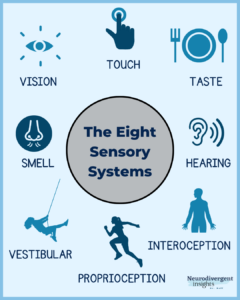By Kimberly Hurley, O.T., Alta Pediatrics
Introduction
Sensory diets are a hot topic these days when it comes to children’s health and wellness. A
sensory diet is essentially a set of activities and exercises that are designed to provide children
with the sensory input that they need to function at their best. Just like a regular diet, a sensory
diet is tailored to the individual needs of each child, based on their sensory profile and the
sensory challenges they face.
The idea behind a sensory diet is that by providing children with the right types and amounts of
sensory input, they can regulate their sensory systems more effectively, leading to improved
regulation, attention, and overall functioning. This can be especially helpful for children with
sensory processing difficulties, ADHD, autism, and other developmental or neurological
conditions. Occupational therapists may recommend a sensory diet or make recommendations
about specific activities to try as part of an overall sensory integration therapy program.
What are the different types of sensory inputs?
The term “sensory input” refers to experiences that stimulate the various sensory systems of
our bodies. Some people with sensory processing issues demonstrate behaviors indicating they
need more input to their sensory systems. Most people would be familiar with the five senses,
but in occupational therapy we are concerned with 8 sensory systems. The below visual from
Neurodivergent Insights provides a visual overview of each. We will discuss these in more detail
below.

Proprioceptive System
Children seeking out rough play, jumping, or crashing may need more input to this system.
Proprioception is one of our movement senses, contributing to coordination and body
awareness. Input to the proprioceptive system may include, stomping, jumping, deep pressure,
and working against resistance or heavy work.
Vestibular System
This is our movement sense. It is related to balance and how we perceive our body’s
orientation in space. Some kids need constant movement and can’t sit still. Others appear
sluggish or lethargic. Vestibular input like swinging, swaying, and bouncing can help to meet a
child’s vestibular needs.
Visual input
Kids who require more visual input may look closely at objects. They may seek out moving or
spinning objects. They may have difficulty focusing on information presented visually.
Flashlight play, toys that light up, and toys with moving parts are all activities that provide visual
stimulation.
Smell and Taste
These two systems are how we process smell and taste. When kids seek out input to these
systems, they may lick or smell objects like crayons or toys. Chewing also provides
proprioceptive input, so kids may bite or chew on objects (think pencils or shirt collars).
These kids may benefit from exploring smells through play with chewy toys, chewing gum,
chewy or crunchy snacks, scented markers, and essential oils.
Auditory input
Sensory experiences that involve sound refers to auditory input. When kids are constantly
humming, yelling, and making other noises, they may need more auditory input than other
children. Good auditory experiences for kids who seek out this kind of input include listening to
music with headphones, playing with toys that make noise, or playing instruments.
Interoception
This is a lesser known sense, but interoception essentially means understanding and feeling
what is going on inside our body. Interoception is relatively new to the field, so there is not as
much research into activities. However, children can benefit from things like yoga that helps
with their ability to slow down, pay attention to the present, and listen to how their body is
feeling. Exploring hot and cold or breathing techniques are other ways to get kids to pay
attention to how their body feels.
Keep in mind that while some kids with sensory processing issues need more sensory input in
one or more of these areas, other kids may be hypersensitive to certain types of sensory
experiences. These children may require less input. They may also require strategies to prevent
negative reactions to these experiences.
What are the components of a sensory diet?
A sensory diet typically includes the following components:
Sensory Activities: Activities that provide input to the different senses, such as sight,
sound, touch, taste, and smell.
Schedule: A structured plan for incorporating sensory activities throughout the day or
week.
Intensity: The frequency, duration, and intensity of the sensory activities are adjusted
according to the individual's sensory needs.
Environment: The environment is modified to accommodate the sensory needs of the
individual, such as providing a quiet space or reducing visual clutter.
What are some real-world examples of a sensory diet?
For a child that seeks out rough play, has trouble calming themselves, and chews objects:
8am.: Have a chewy breakfast or snack, like a bagel or granola bar.
9am.: Carry a crate of books to the school library.
10am.: Hold the heavy library door open for the class.
11am: Squish with a beanbag chair.
12pm.: Lunchtime with chewy options and water bottle with bite valve.
1pm: Do wall pushes.
2pm: Play with crash pad.
3pm: Walk with weighted backpack.
For a child who can’t sit still and constantly touches and fidgets with objects:
8am: Use fidget toy on the bus.
9am: Jump on trampoline.
10am: Play with tactile sensory bin.
11am: Sit in rocking chair for reading time.
12pm: Bounce on a yoga ball.
1pm: Swing at recess.
2pm: Play-Doh time.
3pm: Sit on a yoga ball while doing homework.
Understood.org provides sample activities as well as a worksheet for developing a sensory diet.
It is important to note that the specific sensory activities included in a sensory diet will depend
on the individual's sensory needs and preferences. A trained occupational therapist can help
develop a personalized sensory diet for an individual.
Conclusion
Overall, incorporating sensory diets into children’s lives can be a fun and engaging way to help
them regulate their sensory systems and improve their overall functioning. By using creative
and playful activities that engage multiple senses, children can learn to enjoy and appreciate
Submitted by Ryan Camlin.
Kimberly is an Occupational Therapist and practice owner at Alta Pediatrics.



